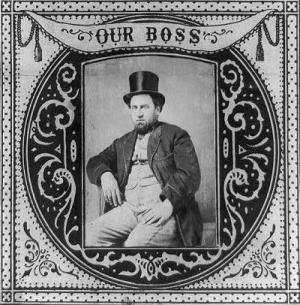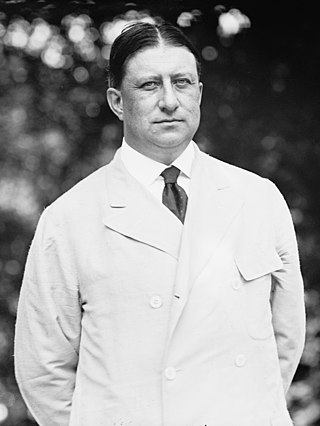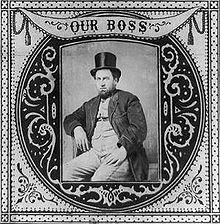The New Deal coalition was an American political coalition that supported the Democratic Party beginning in 1932. The coalition is named after President Franklin D. Roosevelt's New Deal programs, and the follow-up Democratic presidents. It was composed of voting blocs who supported them. The coalition included labor unions, blue-collar workers, big city machines, racial and religious minorities, white Southerners, and intellectuals. Besides voters the coalition included powerful interest groups: Democratic Party organizations in most states, city machines, labor unions, some third parties, universities, and foundations. It was largely opposed by the Republican Party, the business community, and rich Protestants. In creating his coalition, Roosevelt was at first eager to include liberal Republicans and some radical third parties, even if it meant downplaying the "Democratic" name. By the 1940s, the Republican and third-party allies had mostly been defeated. In 1948, the Democratic Party stood alone and survived the splits that created two splinter parties.

Alfred Emanuel Smith was an American politician who served four terms as the 42nd governor of New York and was the Democratic Party's presidential nominee in 1928.

Tammany Hall, also known as the Society of St. Tammany, the Sons of St. Tammany, or the Columbian Order, was an American political organization founded in 1786 and incorporated on May 12, 1789, as the Tammany Society. It became the main local political machine of the Democratic Party and played a major role in controlling New York City and New York State politics, and helped immigrants, most notably the Irish, rise in American politics from the 1850s into the 1960s. Tammany usually controlled Democratic nominations and political patronage in Manhattan for over 100 years following the mayoral victory of Fernando Wood in 1854, and used its patronage resources to build a loyal, well-rewarded core of district and precinct leaders; after 1850, the vast majority were Irish Catholics due to mass immigration from Ireland during and after the Irish Famine of the late 1840s.

Frank Hague was an American Democratic Party politician who served as the Mayor of Jersey City from 1917 to 1947, Democratic National Committeeman from New Jersey from 1922 until 1949, and Vice-Chairman of the Democratic National Committee from 1924 until 1949. During his 30 years as mayor, Hague established reforms and innovations that upgraded the city's infrastructure and services, including the construction of parks, schools, and public housing. He also worked to secure funding for public works projects and attracted new businesses to the city, which helped to boost its economy. Simultaneously Mayor Hague had a dark reputation for corruption, extortion and bossism and has been called "the grandaddy of Jersey bosses". By the time he left office in 1947, he enjoyed palatial homes, European vacations, and a private suite at the Plaza Hotel. His wealth has been estimated to have been over $10 million at the time of his death, although his City salary never exceeded $8,500 per year and he had no other legitimate source of income.

The Stalwarts were a faction of the Republican Party that existed briefly in the United States during and after Reconstruction and the Gilded Age during the 1870s and 1880s. Led by U.S. Senator Roscoe Conkling—also known as "Lord Roscoe"—Stalwarts were sometimes called Conklingites. Other notable Stalwarts included Benjamin Wade, Charles J. Folger, George C. Gorham, Chester A. Arthur, Thomas C. Platt, and Leonidas C. Houk. The faction favored Ulysses S. Grant, the eighteenth President of the United States (1869–1877), running for a third term in the 1880 United States presidential election.

James Aloysius Farley was an American politician and Knight of Malta who simultaneously served as chairman of the New York State Democratic Committee, chairman of the Democratic National Committee, and Postmaster General under President Franklin Roosevelt, whose gubernatorial and presidential campaigns were run by Farley.

William Sulzer was an American lawyer and politician, nicknamed Plain Bill Sulzer. He was the 39th governor of New York and a long-serving U.S. representative from the same state.

Carmine Gerard DeSapio was an American politician from New York City. He was the last head of the Tammany Hall political machine to dominate municipal politics.

Charles Francis "Silent Charlie" Murphy, also known as Boss Murphy, was an American political figure. He was also the longest-serving head of New York City's Tammany Hall, a position he served from 1902 to 1924. Murphy was responsible for transforming Tammany Hall's image from one of corruption to respectability as well as extending Tammany Hall's political influence to the national level. Murphy was responsible for the election of three mayors of New York City, three governors of New York State, and two U.S. senators, even though he was never listed as a leader of Tammany Hall.

In politics, a boss is a person who controls a faction or local branch of a political party. They do not necessarily hold public office themselves; most historical bosses did not, at least during the times of their greatest influence. Numerous officeholders in that unit are subordinate to the single boss in party affairs. Bosses may base their power on the support of numerous voters, usually organized voting blocs, and manage a coalition of these blocs and various other stakeholders. When the party wins, they typically control appointments in their unit, and have a voice at the higher levels. Reformers typically allege that political bosses are corrupt. This corruption is usually tied to patronage: the exchange of jobs, lucrative contracts and other political favors for votes, campaign contributions and sometimes outright bribes.
Politics in Chicago through most of the 20th century was dominated by the Democratic Party. Organized crime and political corruption were persistent concerns in the city. Chicago was the political base for presidential nominees Stephen Douglas (1860), Adlai Stevenson II, and Barack Obama, who was nominated and elected in 2008.
Edward Joseph Flynn was an American lawyer and politician. Flynn was a leading Democratic politician of the mid-twentieth-century, known for his tight control of the Bronx Democratic Party organization after 1922, and his close association with Presidents Franklin D. Roosevelt and Harry S. Truman
The Hofstadter Committee, also known as the Seabury investigations, was a joint legislative committee formed by the New York State Legislature on behalf of Governor Franklin D. Roosevelt to probe into corruption in New York City, especially the magistrate's courts and police department in 1931. It led to major changes in the method of arrest, bail and litigation of suspects in New York City. It also coincided with the decline in Tammany Hall's political influence in New York State politics.

Franklin D. Roosevelt was elected governor of New York in 1928 and served from January 1, 1929, until shortly after his election as President of the United States in 1932. His term as governor provided him with a high-visibility position in which to prove himself as well as provide a major base from which to launch a bid for the presidency.

The Fourth Party System was the political party system in the United States from about 1896 to 1932 that was dominated by the Republican Party, except the 1912 split in which Democrats captured the White House and held it for eight years.

A ward heeler is an American urban political operative who works for a political party in a political ward, the smallest electoral subdivision of a city, usually to achieve an election result. A ward heeler may have controlling influence with a small clique in the ward organization. Often, ward heelers have been low-level operatives soliciting votes and performing campaign tasks on behalf of a political boss, including get-out-the-vote efforts, placing campaign signage, coordination of constituent support, etc. In many urban areas, ward heelers also serve as precinct captains.

The Brooklyn Democratic Party, officially the Kings County Democratic County Committee, is the county committee of the Democratic Party in the New York City borough of Brooklyn. It is the most local level of party governance in New York. Kings County Democratic County Committee is one of the largest Democratic county organizations in the United States, and the largest that is not its own city.

William Barnes Jr. was an American journalist and politician. The longtime owner and publisher of the Albany Evening Journal, Barnes was most notable as a major behind the scenes player in state and U.S. politics as a leader of New York's Republican Party.

The William Barnes vs. Theodore Roosevelt libel trial was a 1915 case between former president Theodore Roosevelt and New York State Republican Party Chairman William Barnes Jr. Barnes sued Roosevelt for libel following accusations of corruption made by Roosevelt against Barnes. The trial became a high-profile news event, and was reported about in newspapers across the country. It ended with Roosevelt's acquittal and played a prominent part in ending Barnes' career as a Republican political leader.

The Platt machine was a United States political organization and coalition of Republican Party members in New York which exerted heavy influence over the state's politics during the Gilded Age. The organization's leadership was maintained by U.S. senator T. C. "Tom" Platt, its "easy boss."

















